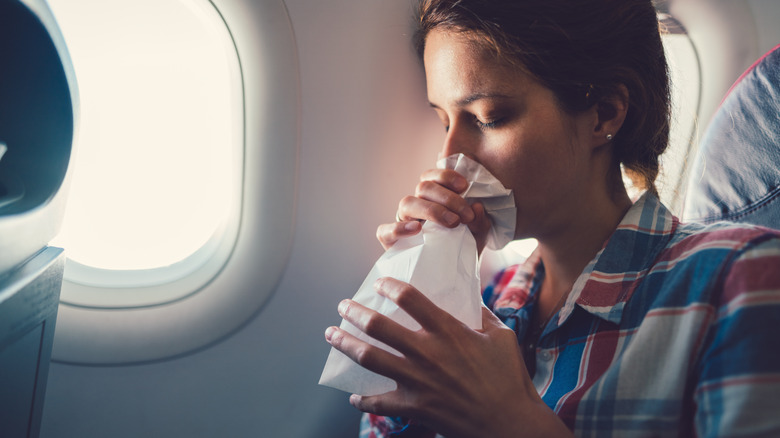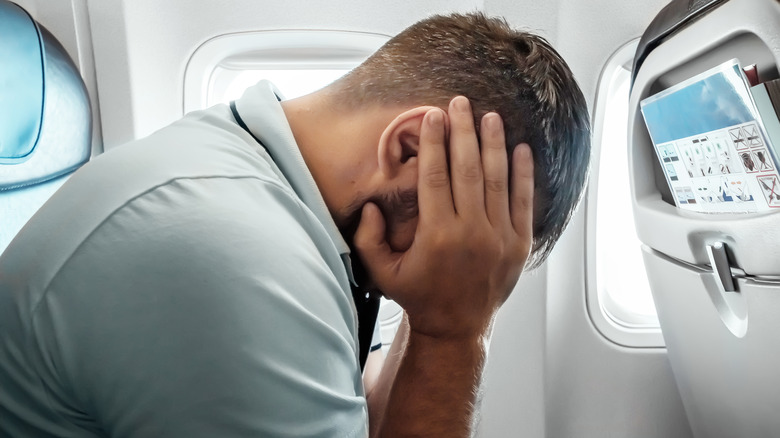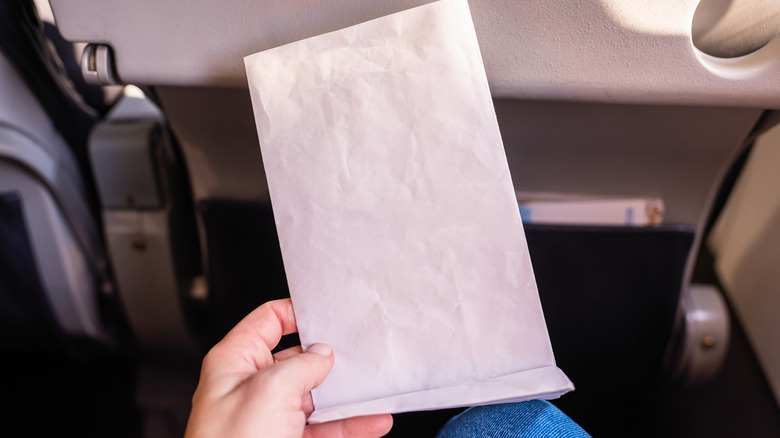Here's Why You'll Hardly Find Barf Bags On Planes Anymore
If you're particularly safety conscious, once you've put your bag in the overhead bin (assuming there's space) and settled into your airplane seat, you might grab the airplane safety card from the seat back in front of you and give it a read. If you're particularly prone to motion sickness or not feeling well, you might be hoping there's a barf bag in the seat back pocket as well. After all, they used to be pretty standard. But those days are long gone, and the sick bag is now rarely seen.
It seems to be because planes fly more smoothly and with less bounce than before, and people aren't getting sick on board the way they used to. That isn't to say that all airplanes have gotten rid of them entirely, but people have definitely noticed seeing them a lot less frequently on board.
Before the leakproof barf bags, some planes had bowls that passengers could use if they got sick. Some airlines offered paper bags that, once used, would be jettisoned via a window. Imagine seeing that falling from the sky! All that changed when Gilmore Tilmen Schjeldahl (an American inventor) patented the plastic-lined air sickness bag in 1949, which found its way onto airlines worldwide in the following years.
Passengers on early commercial flights were more likely to get sick
It wasn't just that people today have stronger stomachs and are better at handling flights. The conditions on airplanes have changed a lot, and they used to create a perfect storm of conditions for throwing up. In the early days of commercial flight, airplane cabins were not pressurized, so they had to fly lower, making for a bumpier ride. Exhaust fumes could also get into the cabin, leading to nausea. Along with turbulence and the fumes, planes tended to be loud and cold back in the day. It was novel, of course, but not very pleasant.
All of that combined seems to have helped create the flight attendant position. The first stewardess was hired in 1930; Ellen Church was a nurse, and this was seen as a benefit for dealing with scared and ill passengers, leading to airlines hiring nurses for flights. Sickness on board was clearly a concern—in an article from The New York Times in 1950, passengers were advised to eat light and skip alcohol before getting on board as a way to help keep them feeling better on board.
Air sickness seems to becoming less frequent over time
Once cabin pressurization was introduced commercially in the 1940s, it allowed pilots to fly the planes higher and to help avoid some of the most dramatic turbulence. Commercial planes were also smaller than they are today; if you've ever been on a smaller commuter jet, you may have noticed you had a bit of a bouncier ride.
As the decades have passed, technology has continued to progress toward helping airplanes fly as smoothly as possible. As advanced as planes may be, there is always a chance of unexpected turbulence when flying, which can shut down the in-flight food and beverage service and give everyone onboard something of a scare. If you are worried about getting motion sickness on a plane, choose a seat over the wing. This should help lessen the feeling of the ups and downs of the aircraft, and you can ask a flight attendant on board for a bag just in case if you notice there isn't one at your seat.
Some people have noticed the lack of air sickness bags more than others. It's not necessarily those who may be prone to motion sickness; rather, it's those who collect air sickness bags — it's a thing! There's even an Air Sickness Bag Virtual Museum, which showcases some of the unique designs on bags from different airlines over the years.


